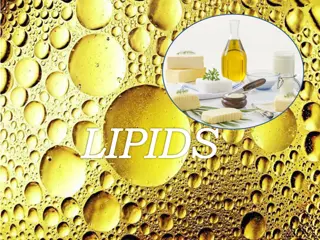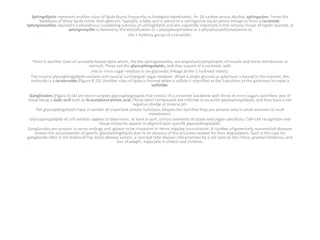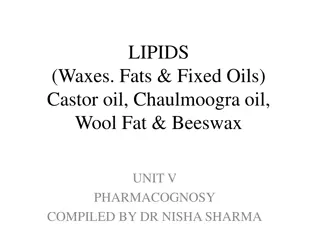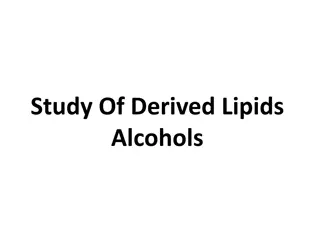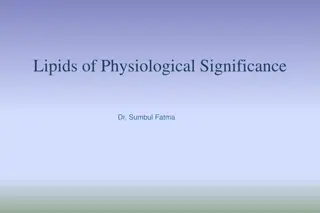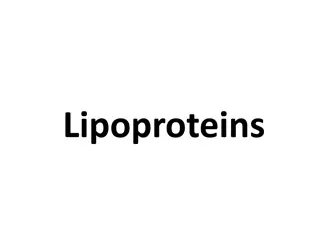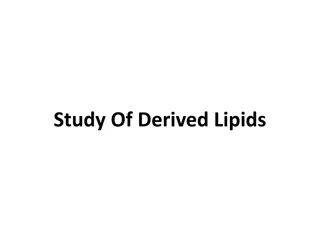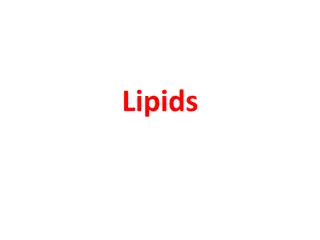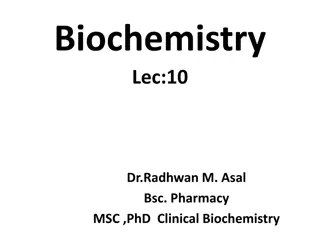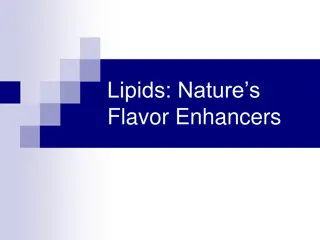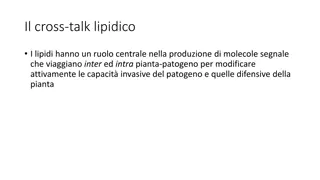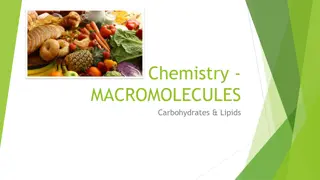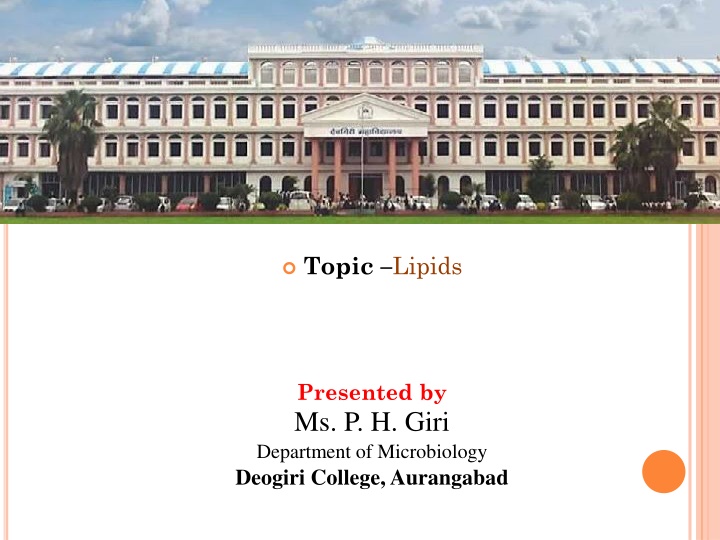
Lipids: Classification and Functions Explained
Explore an in-depth presentation on lipids presented by Ms. P. H. Giri from the Department of Microbiology at Deogiri College, Aurangabad. Learn about the classification of lipids, including simple lipids like fats and oils, and waxes. Discover the functions of lipids as food reservoirs, insulators, and protective materials within the human body. Dive into the world of important waxes like Carnuba wax and Beeswax and their uses in various applications.
Download Presentation

Please find below an Image/Link to download the presentation.
The content on the website is provided AS IS for your information and personal use only. It may not be sold, licensed, or shared on other websites without obtaining consent from the author. If you encounter any issues during the download, it is possible that the publisher has removed the file from their server.
You are allowed to download the files provided on this website for personal or commercial use, subject to the condition that they are used lawfully. All files are the property of their respective owners.
The content on the website is provided AS IS for your information and personal use only. It may not be sold, licensed, or shared on other websites without obtaining consent from the author.
E N D
Presentation Transcript
Topic Lipids Presented by Ms. P. H. Giri Department of Microbiology Deogiri College, Aurangabad
B.SC. F. Y. SEMESTER II PAPER NO. V BASIC BIOCHEMISTRY UNIT 2 LIPIDS Ms. Priyanka H. Giri
LIPIDS: Lipids are heterogenous group of compounds related potentially to the fatty acids. Lipids are classified into different classes:
I. SIMPLE LIPIDS: (F.A. + ALCOHOL) Simple lipids are the esters of fatty acids with various alcohols. (I) FATS AND OILS Fats are the esters of fatty acids with glycerol, which are found richly in nature. Fat's are solid at room temperature whereas oils are liquid.( Fats which are liquid at room temperature are called oils). Functions : (a) Acts as food reserviour in the human body. (b) Acts as insulator for the loss of body heat. (c) Acts as padding material for protecting internal organs.
(2) WAXES These are the esters of fatty acids with higher alcohols and formed as secretions, which are mostly protective in function, by many animals. They resemble fats and are usually solid. The common wax present in human body is esters of cholesterol, found in blood. Waxes contain fully reduced hydrocarbon chains; they are insoluble in water and are very resistant to atmospheric oxidation. They have high melting points and because of these properties they find uses in furniture polishings.
SOME IMPORTANT WAXES ARE - Carnuba wax, obtained from leaves of carnuba palm of Brazil. They are used as an ingredient in the manufacture of polishes; they make an excellent protective coating. Bees wax, it contains palmitic acid ester of myricyl alcohol. Lanolin or wool fat - It is a palmitic, oleic or stearic acid ester of cholesterol.' It is obtained from wool and used as base in making ointments. Spermaceti - It is a liquid wax and it is palmitic acid ester of cetyl alcohol. It has a value as lubricant.
Functions of waxes As a protective agent on the surfaces of animals and plants. Waxes are found on the surfaces of feathers and hair with the result they remain soft and pliable.
II) COMPOUND LIPIDS: ( F.A. + ALCOHOL + OTHER GROUP) Compound lipids are the esters of fatty acids containing groups in addition to an alcohol and a fatty acid. The various compound lipids are as follows (A) Phospholipids : ( Phosphatides) Phospholipids are the esters of fatty acids with glycerol containing an esterified phospharic acid and a nitrogen
Functions Phospholipid is one of the important constituent of cell wall membrane, and acts as carrier of inorganic ions across the membranes. They help in blood coagulation process. They help in absorption of lipids from the GIT, e.g. lecithin. They actively involve in the structures of myelin sheath, microsomes and mitochondria. They act as prosthetic group to certain enzymes. They increase the rate of fatty acid oxidation.
CLASSIFICATION OF PHOSPHOLIPIDS : These are classified as - i. Glycerophosphatide - These includes - Lecithins, Cephalins, Phosphatidyl serine Plasmalogens, Diphosphatidyl glycerols etc. ii. Phosphatidyl inositol - Lipositol or phosphoionositides iii. Phosphosphingosides or spingolipids.
I. GLYCEROPHOSPHATIDES: Lecithins : They are also called as phosphatidyl cholines. Upon hydrolysis they yield glycerol, fatty acids, phosphoric acid and choline. Lecithins generally contain a saturated fatty acid at -position and an unsaturated fatty acid at position. They can exist in or forms. The commonly occuring fatty acids in lecithins are palmitic, stearic, oleic, linolenic and archidonic acids.
Lecithins are waxy, white or yellowish grey solids, becomes brown soon when exposed to air. They are soluble in ether and alcohol but not in acetone. They have the property of forming complexes with lipids, proteins, carbohydrates, etc. and this property is concerned in the ionization and function of many macromolecular cellular components. When the hydroxyl group of choline is acetylated, acetyl choline is formed. Lecithins get broken down by the enzyme lecithinase to lysolecithin. The enzyme lecithinase occurs in venoms of bee and snake cobra. And when injected in blood, lysolecithins bring about rapid haemolysis i of RBCs. Egg yolk is the richest source of lecithins.
FUNCTIONS : 1) Lecithins lower the surface tension of water and help in emulsification of lipid-water mixtures, that help in the digestion as well as absorption of lipids from the GIT. 2) They have very useful function of keeping cholesterol and its. esters in the dissolved state, in plasma. 3) It also has an important role in fat metabolism in the liver. 4) They facilitate combination with proteins to form lipoproteins of plasma and cells. 5) Acetyl choline formed from choline is essentially involved in the transmission of nerve impulses.
CEPHALITIS (PHOSPHATIDYL ETHANOLAMINES) : They always occur in tissues in conjunction with lecithins and having similar properties. The only difference is in the nitrogenous base. It contains ethanolamine. The fatty acid components of cephalins are generally stearic, oleic, linoleic and archidonic acids. They have ethanolamine, colamine and sometimes serine in place of choline.
DIPHOSPHOTIDYL GLYCEROLS : These are two molecules of phosphatidic acid combined by a bridge of glycerol. Phosphatidic acid is important as an intermediate in the synthesis of triacylglycerols and phospholipids. Cardiolipin is formed from phosphatidyl glycerol.
(2) PHOSPHOINOSITIDES OR LIPOSITOL (PHOSPHATIDYL INOSITOL) They have hexahydric alcohol 'inositol'. They can be either mono or diphosphoinositides.depending upon either one phosphate or two phosphates, attached in a- position or in the two a positions joined together by the inositol as bridge.
(3) PHOSPHOSPHINGOSIDES (SPINGOLIPIDS) : These are the lipids in which the trihydroxy alcohol, glycerol, is replaced by a complex amino alcohol 'spingol.' Fatty acid choline and phosphoric acid are the other constituents. Spingomylins are present in brain and nervous tissues. The concentration of these phospholipids is increased in Niemann - pick disease in the liver and spleen

